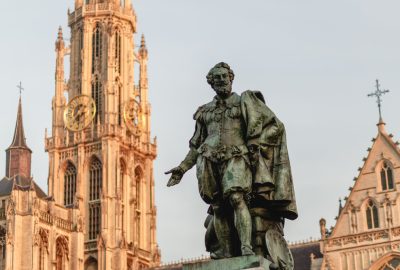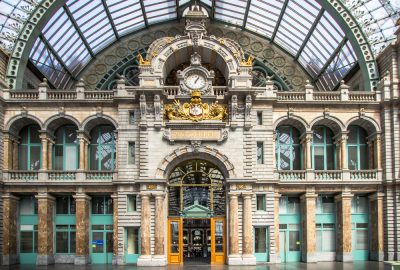Antwerp or Antwerpen, as the Flemish and Dutch say, is considered to be one of the most attractive places to live or to visit when in Europe. The second largest city in Belgium at the Scheldt (Schelde) river lures the biggest names in fashion, clubbing scene, art and even diamond dealers. Luxurious and classy, Antwerp is often called Belgium’s “Capital of Cool” and the place to be for anyone that has more money than they’ll ever need. There are also numerous landmarks and world-famous specialties to try. Even my father, who used to be an officer electrician on tanker ships, used to tell me how Antwerp is one of the most charming and lovely places on earth, and he has seen a lot in his days. Everything worth seeing is within a walking distance of the stunningly beautiful Central Station and the old town, which is built around the most impressive cathedral in Belgium. Another part of town worth visiting is Het Zuid – a former dock area – which acts now as a cultural centre filled to the brim with restaurants, art galleries and nightclubs.
My history with Antwerp dates back to quite some years ago when I went there as a master student facilitated by the renowned EU study exchange program Erasmus. It was only for a few months but it turned out to be an amazing and unforgettable journey and life changing experience. Although Belgium is so close I noticed how completely different it is from the northern neighbour, the Netherlands. They like to dress sharp and stylish and take much more time take to enjoy a decent lunch, to mention a few distinctive features. I remember how astonished I was to find out they even served beer in the restaurant of the university campus. I hardly doubt if that would be still the case nowadays. The Belgians and especially the Flemish are not always fond of the Dutch because they find hem often too loud in public sphere and arrogant. This especially goes for the Dutchmen living up north of the rivers. Being a “Southy” myself I can understand these emotions to a certain extend. Having said that I had absolutely no problems to be accepted by my fellow-students. I got a lot of friends and relatives coming over the weekend and I always enjoyed playing the personal city guide for them.
The main sights have not changed since then. Being a regular train traveller I would usually not advice to include a central station in the sightseeing list; most of the times these are exactly the places you want to leave as soon as possible upon arrival. At least I have that idea always when I arrive on Brussels’s central station, which seems to be in a permanent renovation stage, not to mention Brussels-North station. But for Antwerp Central Station we should make an exception. For good reasons it has been rated as one of the five most beautiful train stations in the world. When you will enter the magnificent main hall you feel like you are in a gothic cathedral and that the catholic mass is going to start any minute. Antwerp is proud of its rich history but is always progressing and looking forward, so also this neo-gothic landmark has also been adapted to modern times with advanced multi-level platforms and smooth escalators.
Right next to the station you will also find the famous Diamond Quarter (Diamantkwartier). Antwerp is still the main global centre of international diamond trade with a daily turnover of more than 200 million dollars. Most of the business is still run by the traditional large Jewish community in Antwerp but nowadays the Indian businessmen are taking a bigger piece of the cake as well. From the station you can walk along the Keyserlei; no need to stop here because with its many fast food restaurants, cliché bars and touristic shops it is not the most beautiful part of the Antwerp. Continue over the impressive Meir shopping alley where the high buildings and more exclusive shops have much more style and grandeur. From there you could make a stop at the Rubens House (Rubenshuis), the Italian-style villa, which was the home and studio of the Flemish painter Rubens. The work of the 17th century Baroque painter has become especially famous for the powerful way he portrayed curvaceous women. His art even triggered the phrase “Rubenesque”, used to describe women with a “fuller“ figure. Close to the Rubens House you can also admire the beautiful Bourla Theatre (Bourlaschouwburg) designed in a neoclassical style. It is a pleasant area with a lot of exclusive antique shops, arts galleries and fashionable restaurants.
Wherever you go in Antwerp; at some stage you will always have glimpse of the elegant spire of the Cathedral of Our Lady (Onze-Lieve-Vrouwekathedraal). According to the original plans the Roman Catholic cathedral would have two towers but due to a huge fire in October 1533, the completion of the second tower was delayed and even led to its ultimate postponement. Explore also the streets and courtyards around the cathedral, the Great Market Square (Grote Markt) and its Town Hall. And do not forget the nearby Schelde bank with its hip bars, outdoor terraces and of course castle Het Steen, the oldest building in town, One of the hidden gems in the centre area is the Vlaeykensgang, the magical hidden medieval passageway that winds round and through the courtyards of the old buildings and is home to some great restaurants.

The Cathedral of Our Lady and the statue of famous Flemish artist Rubens at the Groenplaats: the vibrant heart of Antwerp's historical city centre
The whole venue is buzzing and packed with cafés, restaurants and even a legendary snack bar. I am talking about the one and only Frituur Number One: a longstanding lifesaver for all those who with empty stomachs after a night hard drinking. So you will have plenty of places to choose from to take a well-deserved rest from the intensive sightseeing and shopping. My personal pick would be a terrace on the Hendrik Consience square, next to the baroque Carolus Borromeus church and the old city library. This picturesque square is named after the 19th-century Flemish writer who is said he learned his people how to read. It was the first car-free square in Antwerp in the late sixties and still breathes a very intimate atmosphere. Wherever you go in Antwerp: enjoy the great Belgian cuisine and hospitality. And mandatory: have one of those great Belgian beers on the side. Do as the locals do and order a Bolleke, the amber coloured beer of the iconic local brewery De Koninck. To your health or as they in Anwerpen: Schol!




No one commented yet. Be the first.